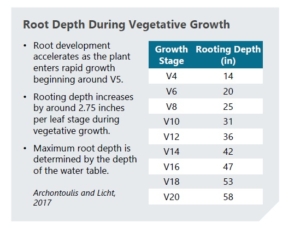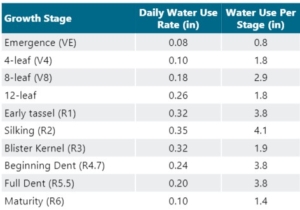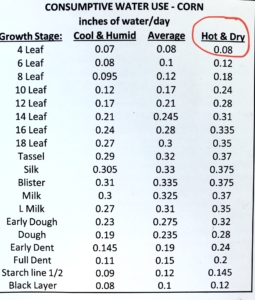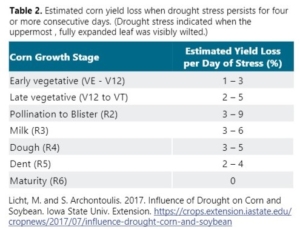CROP WATER USE UPDATE – June 17, 2021…..HOW DRY I AM….
How dry I am….that’s what plants are singing currently!
TOPICS FOR THIS WATER USE UPDATE:
- Crop stage of growth and rooting depths
- ET Usage over the last 14 days
- Crop Response to Drought Stress
- What are the AquaSpy Moisture Probes showing?
- What to think about going into the next few weeks heading into pollination…
CROP STAGE OF GROWTH & ROOTING DEPTH:
 We are currently at 7-9 leaf corn depending upon planting date, tillage and other factors. From the chart, you can see that average rooting depth for V8 corn is approximately 20-25″, depending upon weather conditions, soil type and structure, etc., however, the corn crop should be rooted from 16-24″ at present going off of stage-of-growth. We will show in the video below what the average root depth is for our crop from what the AquaSpy moisture probes are showing…
We are currently at 7-9 leaf corn depending upon planting date, tillage and other factors. From the chart, you can see that average rooting depth for V8 corn is approximately 20-25″, depending upon weather conditions, soil type and structure, etc., however, the corn crop should be rooted from 16-24″ at present going off of stage-of-growth. We will show in the video below what the average root depth is for our crop from what the AquaSpy moisture probes are showing…
ET USAGE:
ET, or evapotranspiration, has been exceedingly high since the beginning of June. Since June 3rd, ET usage has been 5.11 inches for Elgin. Currently we are at 60% of normal precipitation for the past 30 days. Normal precipitation for the month of June is 4-4.5″. In other words, ET usage for the first half of June has been well over the normal rainfall amount we get for the whole month. Daily ET rates for the past 14 days has been .37″/day compared to the normal of .26″/day. This current daily average is higher than this same time period in the last major drought year of 2012. High and low temperatures so far in June are running 6-10 degrees above normal, this has contributed to the increase in usage. Lower than average relative humidity has also contributed to this high ET rate. Daily RH has been running 17% below normal for the past 14 days. The two charts below show ET rates for vegetative and reproductive stages for corn. The chart on the right breaks down ET rates for weather conditions. Note the increase under hot/dry conditions.


Corn Response to Drought Stress:
- Reduced water uptake under drought conditions can limit the rate of photosynthesis in the plant. This can be a huge factor during reproductive stages.
- Corn plants respond to drought stress by closing stomates and rolling leaves to reduce the volume of water transpired through the plant. This response benefits the plant by protecting it through short bouts of drought stress.
- However, closing the stomates also reduces the ability of the plant to take in carbon dioxide, which slows down photosynthesis and growth. This same principle affects herbicide control in weeds as well, as uptake of herbicide is greatly reduced.
- The eventual impact on yield is determined by the severity and duration of the stress. Drought stress lasting four or more days is likely to reduce yield (Table 2 below).t

- Keep in mind the greatest yield loss from moisture stress occurs in the time frame of two weeks prior to, to two weeks after tassel. We will be in this stage in two weeks or so.
What are the AquaSpy Moisture Probes showing?…..
https://www.youtube.com/watch?v=rvdRQ6d9Hhs
Considering that we are currently at 7-9 leaf stage on corn, it is good to see that rooting depths are normal, however, some fields show slightly below normal. An interesting thing that we are seeing so far this year, is that the sand soils are currently rooting the same or, in some cases, better than the clay soils. This is the opposite of most years, as usually the sand soils don’t root as deep as the clay. I think that the clay soils have been slower to ‘get going’ than the sandier soils due to the cold temperatures we experienced for much of May. We see this same temperature effect in high residue areas in the clay soils as well. There is a height and one leaf collar reduction in the high to low residue areas within the field. Sand fields seem to be ‘taking off’ quicker this year than the heavier soils.
What to keep in mind over the next few weeks on irrigation heading into pollination….
Also, keep in mind as we move forward in the growing season that our overall soil moisture profile is not as full as it has been the last few years. As he has been installing the moisture probes, Bryan Bode has mentioned that the 3rd and 4th foot of the profile are much drier than he as seen for awhile. The impact this will have will show up in the reproductive and grain-fill stages. It may be more critical to stay ahead on irrigation this year than other years, as we will not be able to count on the lower profiles giving us as much moisture as normal. In a worse-case scenario of continued dry conditions and hot temperatures through the next six weeks, it will be increasing difficult to ‘push’ water into the 2nd and 3rd foot of the profile when the crop is at peak water use during pollination and blister kernel stages.
If conditions stay as they currently are:
- Good idea to check to make sure your pivots are applying what the timer says it is. Being short .20-.30″ each circle adds up to a lot over the irrigation season. You want to catch this early…..
- Keep in mind control hours on electric pivots, you may want to change control hours as the year progresses.
- Be prepared for wells to lose pressure over time in heavy irrigation periods. May want to check on acid supplies for acidizing wells later in the year.
- Check satellite imagery often starting now and through August to catch any sprinkler issues or water patterns in time for them to be corrected.
- Always keep safety in the forefront as you irrigate….take your time when around power boxes, motors, etc.
Stay safe! Pray for rain!!!!

